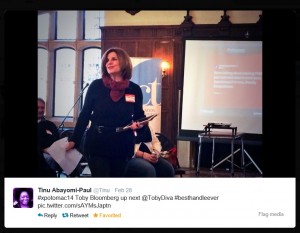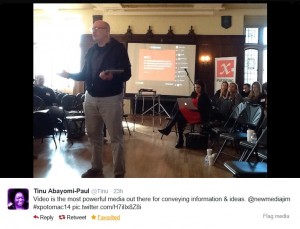 Yesterday I attended xPotomac, a conference on the most influential media technologies most likely to impact businesses and marketers in the immediate future. Both the conference’s content and its organization showcased disrupted shifts in recognizing and harnessing change.
Yesterday I attended xPotomac, a conference on the most influential media technologies most likely to impact businesses and marketers in the immediate future. Both the conference’s content and its organization showcased disrupted shifts in recognizing and harnessing change.
Its organization you ask?
What I found interesting was the fact that none of the speakers used extemporaneous PowerPoints. Instead, they used handhelds with colorful mind maps to remind them where they were in their talk (kudos to Kathryn Garrett for first pointing this out via Twitter). The result was more eye contact and audience interaction than you typically get when speakers are stuck in a pre-personal computer = overhead transparencies paradigm.
The conference room did, however, have a big screen. It was filled with the top tweets and Twitter influencers using the #xPotomac14 hashtag. The result was crowdsourced speaker notes not only perfectly calibrated to audience interests in real time, but also short and sweet enough (due to Twitter’s 140-character limit) to be able to be read quickly without tuning out the speaker. If you have ever developed a PowerPoint, you know it’s hard and time consuming to get buy-in for appropriately concise and readable slides.
This brings me back to a frequent topic, the need to focus many public outreach efforts on mitigating or encouraging specific and pre-determined behaviors appropriate for your audience—not simply raising awareness.
Think about it.
Spreading the word about how great xPotomac’s crowdsourced speaker notes worked is unlikely to result in its replication at conferences outside of tech circles. Touting the benefits of mind maps would be similarly ineffective at invoking change.
Why?
 Because sitting at a conference tweeting on your computer, tablet, or phone is not considered socially acceptable in most venues. Further, most people still are not on Twitter, so the crowdsourced speaker notes would be a flop in most places. Most importantly, the majority of people simply expect to see overhead slides and for audience members to keep their eyes on the speaker or overheads—not their computer, tablet, or phone.
Because sitting at a conference tweeting on your computer, tablet, or phone is not considered socially acceptable in most venues. Further, most people still are not on Twitter, so the crowdsourced speaker notes would be a flop in most places. Most importantly, the majority of people simply expect to see overhead slides and for audience members to keep their eyes on the speaker or overheads—not their computer, tablet, or phone.
The only way an organization could replicate xPotomac’s success is by encouraging Twitter adoption and demonstrating influencers (i.e., bosses and clients in a professional setting) are on board—for both behavior changes.
In other words, to position ourselves and our organizations to compete in the future, it’s not enough to have a few innovators see the potential of the next big thing. It’s a question of reimagining how and why we do things and then ensuring the requisite behaviors are in place, have social support, and are culturally acceptable enough to harness and benefit from the efficiencies of technological change.
That is my main take-away from xPotomac, at least from my strategic communications perspective.
Thank you, Monica! It was great to see you, and I appreciate you coming out on Friday.
I don’t think you can underestimate the incredible impact no powerpoint makes. It forces interaction (as does the seating arrangement), and that makes for a much different, more intimate conference experience. So does the size of the event. xPotomac14 had 100+ people, but you will never see an xPotomac get more than 150 people in the room. It’s about the engagement. The normal conference need not apply!
You are welcome, Geoff! Thank you for organizing the event and making sure I got an email about it on top of your social media posts. Yes, on second thought, the seating arrangement also contributed to the intimate atmosphere and the high level of engagement. There were so many things about xPotomac that made it atypical, innovative, and full of useful information. I am wondering how many other intimate conferences with around 100 people are able to generate enough buzz to make the conference one of the top 100 most popular topics on Twitter in the country and/or reach 20 million people? I am certain few will be able to replicate such success in the near term. Thanks again, Geoff!
Geoff Livingston, one of xPotomac’s organizers, wrote an interesting compendium about the event. The post contains photos of participants tweeting throughout the event and notes xPotomac trended for 35 minutes on Feb. 28, 2014, making it the 68th most popular topic in the country that day, according to Trendinalia United States. Geoff’s post also notes that the official xPotomac influence partner Zoomph calculated xPotomac’s 100 attendees posted more than 3,100 tweets and Instagram updates reaching more than 20 million people on Feb. 28, 2014, and throughout the following weekend.
Great Article, Monica ! Clearly and concisely written.
Thanks, Ronnie!
Here’s an interesting NPR article I saw today relevant to xPotomac’s innovations entitled “Physicists, Generals And CEOs Agree: Ditch The PowerPoint” and available at http://www.npr.org/blogs/alltechconsidered/2014/03/16/288796805/physicists-generals-and-ceos-agree-ditch-the-powerpoint.